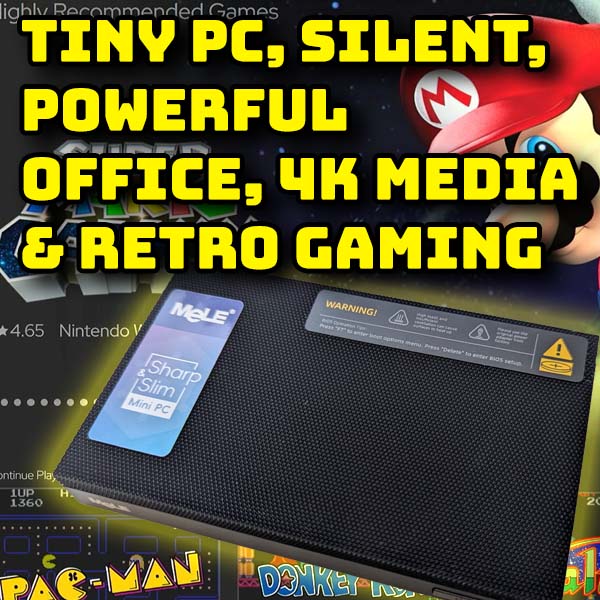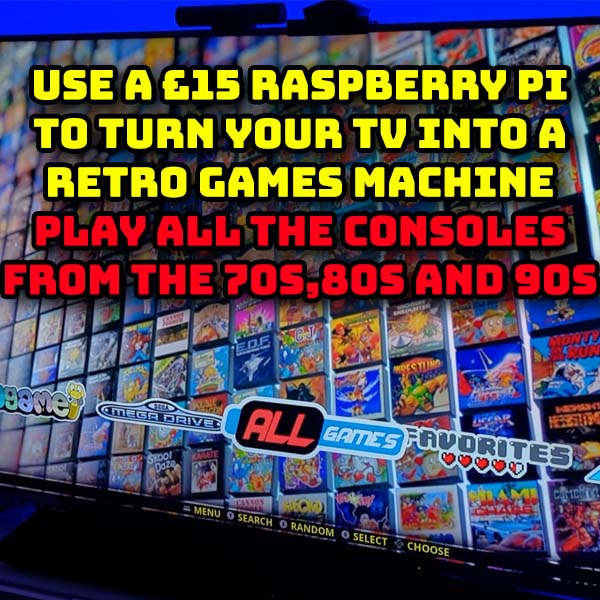
Xbox 360 Bad Update V1.2 – Mod EVERY console and play all the games. No soldering. Just with a USB drive.
9th June 2025
Arcade games on your Xbox360 – Bad Update and RGH/Jtag – Full Mame install and setup
27th June 2025Totally silent PC for Windows, Linux and Retro Gaming. MeLE Quieter 4C with N150 processor.
With so many computing devices on the market it can be difficult to work out which one is going to be the best for you. Processor, RAM, storage, form factor all play a part in your decision and whatever your application there’s going to be a device that will fit your needs.
So I’ve been on the look out for a small, silent Windows PC that I can easily integrate into our family room to give us a full PC whenever we need it on our main TV display. I don’t want a large box getting in the way and I don’t want fan noise drilling its way into our heads when we’re in the room.
So the good people at MeLE were kind enough to send me out one of their MeLE Quieter 4C mini PCs to have a play with.
So in this video we’ll take a look at what it is, what it can do and if it’s the sort of PC that you or I can make good use of.
Parts Used in this video
MeLE Quieter 4C – https://amzn.to/4l9uAUV
Wireless mini keyboards – https://amzn.to/4lt5Ze3
NVMe hard drives – https://amzn.to/3FYN3ED
Wireless game controllers – https://amzn.to/3FX1NUy
External hard drives – https://amzn.to/3HChlOb
Specifications
So, let’s start by looking at what you get for your money.
The Quieter 4C comes in a range of specifications mostly based on the Intel N series mobile processors. The one I have here uses the newer N150 processor which is a four core, four thread device running at 800MHz with a burst speed of 3.6GHz. It’s teamed with 16GB of DDR5 RAM which the processor is capable of running at full speed, so a great update to the earlier N100 versions. For these processors any extra speed on the RAM will help as they only have a single memory channel to move the data around.
This is supported by a swapable 500GB NVMe hard drive running on a 4 channel PCIe 3.0 interface to give you fast data storage and there’s also a micro SD card slot for some additional storage if you need it.
Looking around the device we have an illuminated power switch on the front. On the side we have two USB 3.2 ports capable of up to 10Gbps data rates and one USB2.0 port.
On the back we have a further USB 3.2 data port but using USB C connector which is PD3.0 compatible meaning you can power this PC from a standard USB C power supply. It’s also a video output so you can connect to USB C video devices. The second USB C port is purely a power input for use with the supplied 12V 2A power brick. We also have a 3.5mm jack for speakers and microphone and two 4K capable HDMI output ports. Finally we have a Gigabit Ethernet port for your network connection.
On the last side you’ve got a Kensington Lock slot to stop people from picking this little device up and popping it in their pocket.
Size wise this device is small. Very small. 13 x 8 cms and only 2cm thick. Comparing it to a Raspberry Pi it’s probably only a third bigger on the main dimensions, so this device is certainly not going to take up any desk space and can be easily hidden behind any display. In fact you actually get a VESA mounting bracket in the box so you can do just that.
As I mentioned earlier the MeLE PC is powered by its own 12V power brick. But with such a power efficient device even this is just a very small 24W unit, similar to a phone charger.
This leads us into the main selling point for this device. It is called the Quieter 4C as it is totally silent. The PC is completely passively cooled meaning that there are no fans at all built into the case. The box is designed as an efficient heat sink and dissipater to get the excess energy away from the circuitry to keep the internals at a reasonable temperature. I do say reasonable here as this device does run hot. As you’ll see in my tests it can peak at over 90C with the top surface of the case getting up to 70C under heavy loads. So although it’s a very small device you do want to make sure that it’s in a well ventilated spot so that energy can be convected away. I also found that putting it on a surface that can also dissipate heat really helps to keep the temperatures down.
So overall we’ve got everything we need for a full PC experience built into an amazingly small package. So let’s get it connected up and see what performance we’re getting.
Performance
The standard units come with Windows 11 pre installed so I’ll be using that as my operating system for these tests.
The N150 processor is a fairly new device being released at the end of 2024. It is marketed as a mobile processor and is more powerful than the N100 but only by about 10 to 20%. Having said that I found it works really well in Windows for general usage.
Office applications, browsing and 4K video playback were all as expected with no discernible delays or slowdowns. So if you’re looking for a portable desktop PC this would be an ideal choice. Just plug it into a display, connect your wireless keyboard and mouse and you’re away. Then pop it into your pocket when you’re done and you can carry your whole computer to the next location.
Gaming I’ll come to in a second as this is one of my specific use cases for the MeLE, but suffice to say that this is not a gaming PC. Casual PC gaming will be OK but your triple A titles will definitely not run on the integrated Intel graphics card.
Looking at the benchmarks for the computer I ran it on GeekBench and the MeLE returned the expected performance from an N150 powered computer. For comparison this puts it at about twice the speed of a Raspberry Pi 5 or about 4 times the power of a Pi 4. Running in Windows does sap a bit of that performance compared to a stripped down Linux so if you wanted to install Linux you’d get even better performance from the MeLE.
The supplied disk drive performed well hitting over 3GB/s data rates which is what you’d expect from the PCIe 3.0 four channel interface being used.
Connectivity is either using the built in gigabit ethernet port, or more likely you’ll want to use the dual band WiFi 5 connection. Whist next to my router on the 5GHz band the MeLE was running at my full 500Mbps broadband speed and the built in WiFi only dropped by about 100Mbps when I moved the PC its final destination which involved two brick walls blocking the signal.
Bluetooth is equally good with Bluetooth 5.1 technology providing a strong and fast connection to devices. I didn’t have any problems connecting my keyboard and mouse and even using a Wii controller with my emulators was zero hassle.
So overall the MeLE setup seems to be well tuned and making full use of the processor.
Heat and Cooling
So running the benchmark software puts the system under full load for a sustained period. This is a great way of looking at how well the PC design handles heat dissipation. If we open up the case you can see that the unit is pretty much a sealed unit. There is a sort of heat sink come heat pipe structure beneath the circuit board which will pull the heat away from the electronics towards the case base. And the processor and GPU chips mounted on the top of the board are thermally bonded to the top surface of the case.
This top surface is designed to both radiate and convect the energy away. If you look very closely at the surface you’ll see that it is covered in small pyramid bumps. These are designed to double the total surface area of the case to provide better heat control, and they do work very well.
During the tests the CPU temperatures got up to the mid eighties centigrade touching 90C on a couple of occasions with the case surface temperature topping out in the upper sixties. That’s quite warm to the touch but the system did stay within its operating temperature range and I didn’t see any thermal limiting on the performance. Having said that if you were to enclose this device into a small area I do think you could give yourself some problems as the heat would just have nowhere to go.
Upgrading the PC
On the upgrade side, as with most of these mini PCs, you’re very limited on the internal front. The system RAM is soldered to the motherboard so you’re not able to upgrade that. You can however upgrade the NVMe drive. This uses the standard M.2 2280 format and will take drives up to 4TB in size using either the NVMe interface, or SATA if you want to go that route.
Externally you’ve got the USB 3.2 ports. These will allow you to connect the usual peripherals that you might want to use including external hard drives. With the USB 3.2 spec ports this will give you just over 1GB/s or 10Gbps transfer rates which is what I was able to get with my NVMe external drive. With effectively 4 ports this should give you enough scope to get connected without having to resort to a USB hub.
Using the MeLE Quieter 4C
So with all the specs and figures out of the way, what is the mini PC like to use?
These devices are fantastic for fitting a full powered PC into places where a standard desktop box wouldn’t work. Size is always a consideration and these of course take up no room at all. They will easily slip behind your TV and easily vanish from site.
Where this MeLE PC does really win out in in the noise level. It is completely silent. Not just quiet, silent. My use case was to install a PC onto our family TV and I did not want any fan hum going on in the background. This is the perfect device for this scenario. I could also see if you’re working in a quiet office or needed to have a lot of PCs running together this would eliminate that annoying background noise level. So the Quieter 4C it really does what it says on the tin.
In terms of economy the PC runs normal office tasks at 10W or below, peaking to about 17W or 18W under heavy load. In sleep mode my power meter couldn’t read the actual load so it’s going to be under 1W. This makes the MeLE ideal for my sort of application where I can just leave the PC in sleep mode until I need to use it and when finished just let it naturally go back to sleep. At these power usage levels it will barely even register on your electricity bill. In the UK this works out at around 0.25 pence per hour when being used with 1 pence covering about 2 days in sleep mode.
So we’ve got a silent computer that costs next to nothing to run and that can do all your normal day to day tasks.
Let’s now look at what I’m going to be using it for.
Retro Gaming
As I mentioned this is destined for our main family room and to turn our TV into a full PC when we need it. We already have an Amazon Fire TV plugged in, but sometimes you just need the power of a full PC.
We probably won’t use it for media streaming, but it will easily cope with that. YouTube, Netflix, Prime, Disney etc. all run at full 4K speeds over WiFi.
To control the computer I’m using this mini keyboard and mouse unit. This gives me a really neat and handheld friendly way of using the Windows PC so I don’t have the hassle of a full keyboard and mouse lying around the room. Using the 2.4GHz USB connection lets me wake the PC from sleep by just pressing a keyboard button so the whole power saving sleep mode scheme just works seamlessly.
Where I really wanted the PC to shine was in retro emulation. I’d used a Raspberry Pi 4 before for this application but that wasn’t ideal and didn’t give me the emulation coverage I wanted.
So here I’m using an application called Launchbox which is a full gaming front end for Windows which lets you bring all of your PC and emulation gaming into one really cool application. I’m actually using the BigBox version which lets you run the front end as a full screen system which gets rid of the Windows parts of the screen and just leaves you with this great gaming experience.
As you can see I’ve loaded up a few retro systems so that we can see what the mini PC can do.
As you expect all of the older systems from the 8 bit, 16 bit and 32 bit eras work seamlessly so we can play all the old Nintendo, Sega, Atari and so on games. And the MeLE has no problems with the slightly later systems such as the Nintendo 64 and Sega Saturn.
Arcade emulation is all there so whether you’re into the classics such as Galaga, or Donkey Kong or any of the later arcade titles you’ll have no problem playing them.
But where I really wanted to go with this system was to be able to play some of the more advanced consoles.
With this device I can emulate almost everything up to and including the PlayStation 2 and Nintendo Wii. Both of these run at full speed.
Here I’m using the Dolphin emulator to play Nintendo Wii games. With this you can attach original Wii controllers and sensor bars to get the full Wii gameplay experience. If you’re not familiar with the Wii this console used a motion sensing controller to allow you to swipe and swing movements to control the action, great for games like tennis and sword fighting and so on.
The MeLE has no problems picking up the BlueTooth connection from the controllers and as you can see we’re getting full speed emulation on this fun console. So we’ve got access to the full Wii games catalogue on our TV.
Similarly the mini PC is powerful enough to give us full PlayStation Portable and PlayStation 2 emulation. PS2 and Wii are both a bit of a struggle for Raspberry Pis but the MeLE copes really well.
This is God of War running on the PlayStation 2 emulator which is one of the harder titles to emulate at full speed. But the PC is coping very well giving us excellent gameplay so we’ll again have full access to the extensive PS2 back catalogue of games.
Beyond the PS2 the PC does finally run out of steam.
Using the Xemu emulator to play Original Xbox games shows the limits of the system with complex scenes bringing the processor to very slow framerate.
But this still left the PC giving much better performance than I was expecting and adding another generation of consoles to the mix beyond what a Raspberry Pi 5 could manage. So overall I’m really happy with the outcome.
Conclusion
So that is the MeLE Quieter 4C mini PC with the Intel N150 processor.
It’s a great little machine that really does perform well. Obviously there are a number of alternative mini PCs around using the same chip set including the Beelink and others. Most of these are a bit cheaper then the MeLE which sells for around £250 compared to an equivalent Beelink EQ 14 at £210. But you do get a smaller physical package and above all a totally silent computer, both of which were worth the extra cost for my application.
So please do check out the PC and I’ll put some links down in the description.




